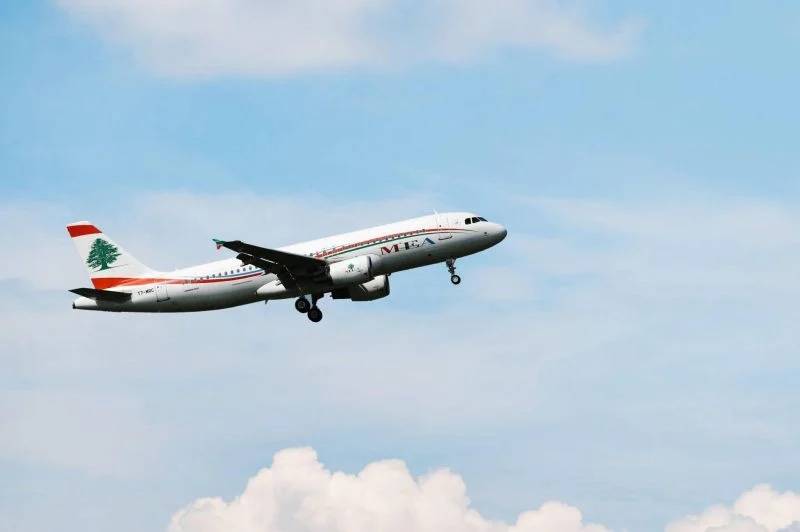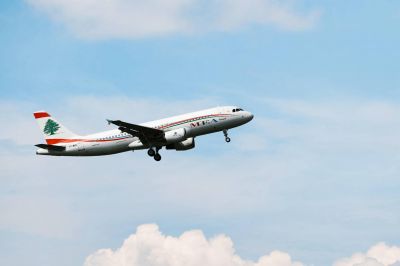
An Airbus in the colors of the MEA in full flight. (Credit: Mohammad Yassin)
Every festive and high season, Lebanese passengers share on social media their wrath about flight ticket prices to and from Beirut.
After a period of relative calm, due to the curtailment of travel throughout the COVID-19 pandemic, this chronic controversy appears to have returned in full force in 2023.
As is often the case, a significant number of comments are aimed at Lebanon’s national carrier, Middle East Airlines, of which Banque du Liban is a key shareholder via Intra Investment.
According to many Lebanese living abroad, flight fares have risen sharply compared with previous years, and MEA fares even more than others. The MEA management responded by acknowledging that its ticket prices have indeed risen “by nearly 18 percent since 2019,” but remain below “the average prices worldwide.” MEA also stated that its fares have only increased by 1 percent this year compared to 2022.
 MEA Commercial Director Marwan Haber in his office. (Credit: PHB)
MEA Commercial Director Marwan Haber in his office. (Credit: PHB)
The passengers’ point of view
Forced to reconsider their holiday plans or even cancel them, all the travelers and would-be travelers interviewed expressed alarm at MEA fares they say have risen considerably this summer.
“A Paris-Beirut flight with MEA exceeds $1,600. This is unrealistic!” said Serge Zamora, who did not hide his anger. The young data consultant, who works between Paris, London and Beirut, had to delay his return flight last month due the high prices.
“Air France was offering a similar ticket for around $1,000 on the same date, but I ended up flying back with Pegasus at half the price, which is still expensive for a flight with a stopover,” he added.
This summer some expatriates have decided against their usual seasonal visit to Lebanon. Such is the case of Omar Rajab, a cybersecurity consultant in Paris. “This summer is different from previous seasons, when a round trip ticket costs around €1,000. This year, in June, MEA was advertising round trip tickets at 2,400 euros (about $2,614) between July 19 and Aug. 20, which for a family of four is equivalent to 9,600 euros,” he said.
For the 23-year-old, the high ticket fares also have a political dimension. “BDL owns 99 percent of MEA’s shares. So, most of the money is not going to the government, but to thieves and the corrupt,” he added.
While he acknowledged that the “significant” increase in MEA ticket fares is probably linked to inflation, Sami Bou Chalhoub, a London-based French-Lebanese merchant, said that they are still “unusually high,” even when booked more than six months in advance.
“I paid $530 last August for a London-Beirut ticket in November 2022. This year, the same ticket costs $760, even though I booked it eight months in advance,” he said.
Taking a better look at it, the problem seems to have more to do with Lebanon as a destination than with the national carrier.
“If you compare them [the Paris-Beirut flight price] to the price of a flight from Paris to Tel Aviv, which a relatively similar distance … (around 3,200 km), the price of a ticket from Paris to Beirut is almost double on the same day,” said Serge.
L’Orient-Le Jour checked on July 4 checked the Air France website to find a ticket from Paris to Beirut on July 10 would cost €1,372, compared with €673 for a flight from Paris to Tel Aviv on the same date.
Various factors and a given moment
MEA management said that the prices charged by the national carrier are neither the best on the market nor the most expensive. Speaking to L’Orient-Le Jour, Marwan Haber, head of commercial at MEA, shed light on the results of a search on Skyscanner, a meta search engine.
The search was carried out in mid-June. For a direct return flight between Paris and Beirut between July 18 and 26, 2023, MEA displayed a maximum price of $1,340, slightly cheaper than Air France ($1,350), and around $100 more expensive than low-cost carriers Transavia and Pegasus (the first through Paris’ Orly airport and the second through Istanbul).
Haber carried out the same search for L’Orient-Le Jour using the same factors for a round trip flight between Dubai and Beirut: MEA once again finds itself within the mid range with a ticket costing $470, cheaper than Emirates ($590) and low-cost carrier Air Arabia ($520) and not much more expensive than Flydubai, another low-cost carrier.
Speaking to L’Orient-Le Jour, Jean Abboud, president of the Association of Travel & Tourist Agents in Lebanon, also placed MEA fares within the mid-range. He called on passengers to take into account the factors that cause ticket prices to change for the same destination.
“At any given moment, there are three main factors: whether or not it’s a direct flight; the timing, i.e., at what time of the year and at what schedule; and finally, the relationship between supply and demand,” he said.
“For instance, for the same destination at the same time of year, the price of the ticket may vary depending on the booking that the traveler is looking for, i.e. whether it starts on the eve of a weekend or at the beginning of the week,” he added.
A tour operator who declined to be named for professional reasons indicated that demand this year for direct Paris-Beirut flights has been particularly high, which he believes explains the significant rise in prices on this route this summer.
Passenger numbers at Beirut International Airport have risen sharply compared to 2022, namely by 23 percent in the first half of the year for a total of 3.17 million passengers, 51 percent of whom were arrivals, according to the latest official figures.
Haber indicated that ticket prices are generally much higher during the high season, whether to Lebanon or elsewhere. “For information purposes only, one can fairly say that they can easily be 40 and 50 percent higher on average, but this percentage is not set in stone,” he said.
Professionals in this sector are used to adjusting prices throughout the year to make up for losses incurred during off-peak periods through the profits generated during periods of high demand.
Abboud elaborated on this point. “Generally, carriers put a certain number of seats for a given route on sale a year in advance at a reduced rate. Once these seats are sold out, they market a second series at higher prices, and so on. So, for a popular destination, it’s hard to find cheap fares if you are too late. Fares that are available one day can become unavailable the next day.”
Global increase
But even when taking these specific factors into account, airline industry professionals and experts around the world have acknowledged for several months now that fares have risen enormously compared with the pre-COVID-19 period. In France, the increase was more than 32 percent on average at the end of April, according to the country’s Civil Aviation Authority.
There are many reasons behind this rise, but they are mainly linked to the consequences of COVID-19 and the Russian-Ukrainian conflict, which have had an impact on air transport activity (travel restrictions, airline suspensions and even higher fuel prices), and disrupted supply chains worldwide.
“On the one hand, demand is higher than expected,” said Haber, indicating that traffic should return to 2019 levels as early as the first quarter of next year instead of 2025, as initially projected by the International Air Transport Association (IATA).
“On the other hand, supply has not kept pace,” he added, in reference in particular to delays in the delivery 0f aircrafts. “And finally, carriers’ costs have risen due to global inflation, which has not been limited to fuel,” he said.
In particular, Haber cited increases in overflight charges imposed by countries, airport handling charges, maintenance costs, in-flight catering and insurance services, salaries for flight and ground staff, etc. All these elements, plus the airline’s margin, are taken into account when calculating the ticket price.
According to Haber, fuel and handling costs alone account for almost half the price.
Finally, the last factor to be taken into account when explaining the current flight price rise is the fact that between 2020 and 2022, carriers accumulated almost $190 billion in losses due to the almost total halt in activity as part of the measures to fight COVID-19 worldwide.
Some have lived off their shareholders’ reserves, as is the case in the Gulf, while others have benefited from massive government aid that they have had to reimburse, as is the case of Air France-KLM, which in the spring repaid €3.6 billion in aid.
This article was originally published in French in L'Orient-Le Jour. Translation by Joelle El Khoury.

